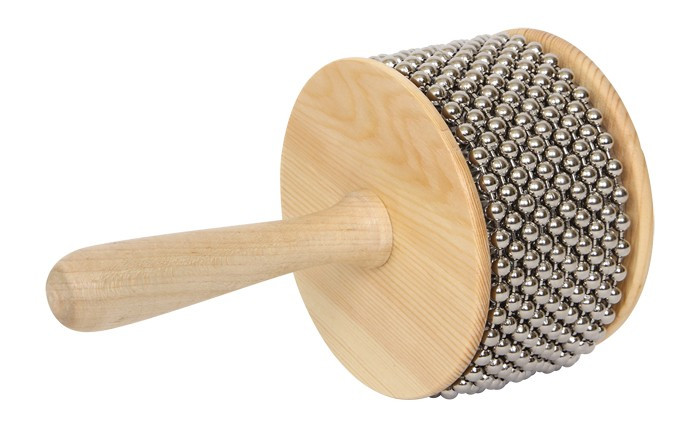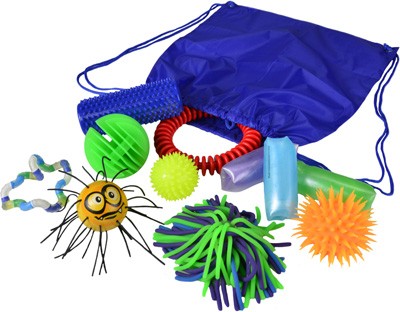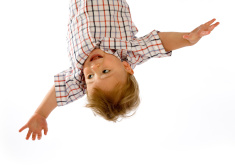Something’s Touching Me!
Your body is always touching SOMETHING. What an interesting thought that most people don’t spend too much time dwelling on. That’s because the brain with a well-regulated tactile sense only briefly makes note of the thing that the body is touching, and then ignores it in favor of more important thoughts and sensations it needs to process. But for a person whose tactile sense is out-of-sync, the textures of certain fabrics or presence of a tag on their clothing may be a source of extreme discomfort and the cause for much distress. Or they may lunge at you for a bear hug because they crave the feeling of deep pressure squeezes. Or they may not seem to notice that their hand is on a hot pan until they have a third degree burn. These are only a few examples, of course. The main point is, our tactile sense helps us determine what we are touching and if the things touching us at every moment of every day are harmful or helpful. An out-of-sync tactile sense may make a person overresponsive to stimuli, underresponsive to stimuli, sensory seeking, or a combination of these, or may make it difficult to determine what the tactile stimulus is or where it is touching.
How does this affect my work as a music therapist? I can start by considering the environment of my treatment space. What is the client’s reaction to the texture of the chair he/she is sitting in? For some of my clients with tactile sensory needs, sitting on a fuzzy pillow that buzzes provides the tactile sensations they need to be aware and in control of their bodies. For other clients, sitting on a rubbery and bumpy cushion serves this same purpose. What is the client’s reaction to the carpet? I have clients who prefer to have their shoes off during sessions. One such client likes having the afore mentioned rubbery cushion under his feet. From which direction is the air conditioning blowing and is it blowing directly on my client? I’ve barely scratched the surface of tactile elements to consider in the environment of the treatment room, but you get the picture.

What about my choice of instruments I use with my clients? Does the client seem to want to touch textured things? I have many clients who are more engaged in our interventions when they play an instrument like the cabasa (picture below), which allows them to rub their fingers along the bumpy beads. Other ideas of instruments with great sensory feedback are guitar strings, chimes, hand drums, ocean drums, and resonator bells. The cabasa is one of my favorite instruments because it acts as a great massager, providing sensory input to arms, legs, backs, and soles of feet. For clients who are seeking tactile sensory stimulation, instruments like the cabasa can provide this in an appropriate way. Encourage the client to play the cabasa (or other instrument) and use it to provide sensory input independently. This way, the client is learning to self-regulate his/her out-of-sync sensory systems.
 Or for clients with an overresponsive tactile sense, choose instruments that don’t have a rough or uneven texture. Then encourage them to explore tactile sensations using the texture and vibrations of various instruments. This could help reduce defensiveness to certain tactile sensations.
Or for clients with an overresponsive tactile sense, choose instruments that don’t have a rough or uneven texture. Then encourage them to explore tactile sensations using the texture and vibrations of various instruments. This could help reduce defensiveness to certain tactile sensations.

As with all other sensory systems, there are so many things to consider when your child or client has an out-of-sync tactile system. Hopefully the ideas and considerations discussed here have sparked some ideas and increased your awareness of needs related to the tactile sense. Now, I challenge you to stop every now and then and become aware of the sensations on your skin and the things touching your body. Then imagine what it would be like if you could not seem to get enough of or control one of these sensations. How would you fix that?
-Chiara






 What happens if one of your clients or your child has an out-of-sync vestibular system? They may be underesponsive or overesponsive to vestibular stimuli, or they may seek or crave vestibular stimulation. Any of these forms of sensory processing disorder can cause disturbance and frustration in their everyday functioning. Is the client terrified of moving/being moved? They may have an overesponsive vestibular system. Does the client not notice they are moving? They may have an underesponsive vestibular system. Does the child crave swaying, spinning, or being upside-down? They may be seeking more vestibular stimuli. The challenge arises in the fact that the child’s behaviors are not always so straightforward, and the category of sensory processing disorder under which their symptoms and behaviors fall may not be very clean cut. What I found most challenging is, how do you determine what sensory needs the child has and how to best address them?
What happens if one of your clients or your child has an out-of-sync vestibular system? They may be underesponsive or overesponsive to vestibular stimuli, or they may seek or crave vestibular stimulation. Any of these forms of sensory processing disorder can cause disturbance and frustration in their everyday functioning. Is the client terrified of moving/being moved? They may have an overesponsive vestibular system. Does the client not notice they are moving? They may have an underesponsive vestibular system. Does the child crave swaying, spinning, or being upside-down? They may be seeking more vestibular stimuli. The challenge arises in the fact that the child’s behaviors are not always so straightforward, and the category of sensory processing disorder under which their symptoms and behaviors fall may not be very clean cut. What I found most challenging is, how do you determine what sensory needs the child has and how to best address them?